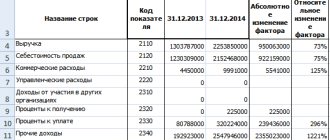Unified agricultural tax: what kind of taxation system is it?
The unified agricultural tax is a system that involves its use by business entities subject to compliance with the criteria established by law. The tax itself replaces the income tax for organizations for companies and personal income tax for entrepreneurs.
In 2021, entities using this system are also exempt from VAT. However, starting in 2021, this rule is changing - payers will be required to determine and pay VAT, and will also be able to deduct input tax.
The Tax Code establishes that it will be possible to obtain tax exemption, but for this, income will have to fall within the established limit.
For 2021 it is set at 100 million rubles, for 2021 - 90 million rubles and then in descending order. Attention: starting from 2021, entities using the Unified Agricultural Tax system must pay property tax.
Property that is used directly in the production of agricultural products will not be included in the base. In connection with the introduction of sanctions and a significant increase in agricultural production, a further increase in the tax burden on this system is possible.
This system can only be used by those entities that carry out primary processing of their own agricultural products, and is not available to those involved in secondary processing. The transition to agricultural tax is voluntary.
Attention: when using Unified Agricultural Tax, a business entity has the right to use UTII for other types of activities. However, it is imperative to control the share of revenue from core activities.
Using this system, it is possible to obtain benefits for paying social contributions on the earnings of registered employees from companies and entrepreneurs.
Conditions for applying the Unified Agricultural Tax in 2018
To use the Unified Agricultural Tax in 2021, several criteria have been defined that all organizations and entrepreneurs must meet:
- Activities take place in animal husbandry, crop production, fisheries;
- All entities using the system must be engaged in the production of agricultural products, and not just their processing. The share of income from production must be at least 70% of the total size;
- The subject is engaged in fishing, belongs to the city-forming enterprises, the number of registered employees does not exceed 300 people. Also, the vessels that are used in this activity can be either their own or hired under a charter agreement. The share of basic income must also be above 70% of the total.
- The business entity provides services for field preparation, sowing and harvesting, grazing and moving livestock, etc. For the main revenue, it must be more than 70% of the total revenue.
- The entity is an agricultural cooperative that sells its own agricultural products. The share of revenue from core activities must exceed 70% of the total amount.
Important: agricultural tax cannot be used by those who produce excisable products, organize gambling, or are state-owned, autonomous or budgetary institutions.
Who has the right to apply the Unified Agricultural Tax
In clause 2.1. Chapter 346.2 of the Tax Code of the Russian Federation determines that the following have the right to use a special taxation regime in business activities:
1. Organizations and individual entrepreneurs producing agricultural products, carrying out their primary and subsequent (industrial) processing (including on leased fixed assets) and selling these products, provided that in the total income from the sale of goods (works, services) such organizations and individual entrepreneurs, the share of income from the sale of agricultural products produced by them, including their primary processing products produced by them from agricultural raw materials of their own production, is at least 70 percent.
2. Agricultural consumer cooperatives (processing, marketing (trading), supply, horticultural, vegetable farming, livestock farming), recognized as such in accordance with Federal Law of December 8, 1995 N 193-FZ “On Agricultural Cooperation”, which have a share of income from sales agricultural products of own production of members of these cooperatives, including primary processed products produced by these cooperatives from agricultural raw materials of own production of members of these cooperatives, as well as from work (services) performed for members of these cooperatives, does not account for the total income from the sale of goods (work, services) less than 70 percent.
3. City- and settlement-forming Russian fishery organizations, the number of employees in which, taking into account family members living with them, is at least half the population of the corresponding locality.
4. Agricultural production cooperatives (including fishing artels (collective farms).
5. Fishery organizations and individual entrepreneurs, subject to their compliance with the following conditions:
- if the average number of employees during the tax period does not exceed 300 people;
- if in the total income from the sale of goods (works, services) the share of income from the sale of their catches of aquatic biological resources and (or) fish and other products from aquatic biological resources produced on their own from them is at least 70 percent for the tax period;
- if they carry out fishing on vessels of the fishing fleet that belong to them by right of ownership, or use them on the basis of charter agreements.
Since January 1, 2017, Federal Law No. 216 dated June 26, 2016, this list has been expanded:
LLCs and individual entrepreneurs that provide services to agricultural producers in the field of livestock and crop production have the right to apply the Unified Agricultural Tax. These services include the following under the Tax Code of the Russian Federation:
In crop production: preparing fields, sowing, cultivating and growing crops, spraying, pruning fruit trees and grapes, replanting rice, planting beets, harvesting, treating seeds before sowing.
In livestock farming: inspection of the condition of the herd, movement of livestock, grazing of livestock, culling of poultry, keeping and caring for farm animals.
Provided that the share of income from the sale of the above services must be at least 70% of the total income.
The procedure for transition to a single agricultural tax
There are several ways to start using this system:
- From January 1 of the new year. In this case, the notification must be sent before December 31 of the year preceding the year of intended use of this system;
- By submitting an application to switch to the system when registering a new business entity.
If at the time of registration of the subject the tax system was not selected, then the transition can be made within thirty days from the date of receipt of registration documents. Moreover, the day on which the business entity was registered will be considered the day when the use of the agricultural regime began. It is indicated in the extract from the unified register of the Unified State Register of Legal Entities or the Unified State Register of Legal Entities.
The application for transfer must be submitted for companies - at their location, and for entrepreneurs - at their registration address.
Business entities make the decision to use the Unified Agricultural Tax regime independently. To do this, they need to compare the pros and cons of all other tax systems.
If the Unified Agricultural Tax is applied through a transition from a different tax system, then the application must indicate the share of proceeds from the sale of agricultural products in total revenues. This indicator is determined based on data from the previous year of work.
Attention: before starting to use the unified agricultural tax, a business entity must notify the tax authority about this. If this is not done, then the right to use this system will not be established, and the tax authority will consider that the company or individual entrepreneur is on the previous system.
When switching to the Unified Agricultural Tax, it must be applied before the end of the current year. It is prohibited to refuse to apply it if all criteria meet those established by law.
Application area
It is possible to use the Unified Agricultural Tax if:
- the taxpayer meets all the requirements for the transition (is an agricultural producer, the share of income from the sale of agricultural products is more than 70% of total income, etc.);
- The tax authority was notified by December 31 of the year preceding the year of transition to the Unified Agricultural Tax, using the KND form 1150007.
Not only existing legal entities and individual entrepreneurs who operate under a simplified or other taxation system can switch to a single agricultural tax. Newly registered persons can also do this - to do this, within 1 month after the issuance of the registration certificate, they must submit a notification in the same form (KND 1150007).
Calculation of the unified agricultural tax
In order to calculate the amount of tax, it is necessary to use the base in the form of the amount of income received, which is reduced by the amount of expenses incurred in the same period. The exact list of expenses is determined in the Tax Code, and currently includes more than 40 items.
For the Unified Agricultural Tax, the rate is currently set at 6%. In Crimea and Sevastopol, the 4% rate continues to apply in 2021. From 2021, municipal authorities can set a differentiated tax rate from 0% to 6%, based on the category of payers.
In order to calculate tax amounts, a business entity must keep accounting records. Moreover, both companies and entrepreneurs should do this.
The value of income and expenses during the year must be recorded on an accrual basis.
Let's look at tax calculation as an example.
Kuritsa LLC uses an agricultural tax system and applies a rate of 6%. In the period from January 2021 to July 2021, it received income in the amount of RUB 10,800,000. At the same time, the company confirmed expenses in the amount of RUB 5,450,000. At the end of six months, the accountant needs to calculate the down payment.
The payment amount is (10,800,000-5,450,000)x6%=321,000 rubles.
This payment must be made by July 25, 2021.
After this, between July and December 2021, Kuritsa LLC received income in the amount of 8,320,000 rubles, and at the same time incurred expenses of 6,890,000 rubles.
Since the calculation must be made on an accrual basis, then:
(10800000+8320000)-(5450000+6890000)x6%=406800 rub.
Since an advance payment was made for the first six months, the following amount must be paid:
406800-321000=85800 rub.
This tax is transferred until March 31 of the year following the year of calculation. The same deadline is set for sending a tax return.
What are the deadlines for submitting the Unified Agricultural Tax for 2021?
The agricultural declaration is sent to the regulatory authorities only at the end of the tax period - the year. No other reporting on this tax is provided within it.
The declaration is submitted to the inspectorate at the location of the taxpayer no later than:
- March 31 of the year following the expired tax period - based on its results;
- On the 25th day of the month following the month in which the economic entity ceased agricultural activities - in case of its termination.
The report can be submitted:
- on paper, provided that the average number of employees for the previous period (year or month) did not exceed 100 people (in this case, it can be submitted to the inspectors personally or sent by Russian Post);
- in electronic form via TKS.
NOTE! If you were required to submit an electronic form of the document, but instead submitted a paper one, you will be punished with a two-hundred-ruble fine under Art. 119.1 Tax Code of the Russian Federation.
Reporting
The use of the regime with payment of the Unified Agricultural Tax implies the obligation for its payer to submit a declaration annually on time, as well as at a certain time to make calculations and transfer tax payments to the budget.
This responsibility rests with the head of the company, accountant or other representative acting on the basis of a executed power of attorney.
The Unified Agricultural Tax declaration can be submitted personally to the inspector, sent by mail, or through the document management system.
The tax return for the unified agricultural tax must be submitted once, after the end of the calendar year, until March 31 of the following year after the reporting year.
However, if the regime was not used for any reason by a business entity for the entire reporting period, then it must be sent to the tax office before the 25th of the next month, after the end of the application of the Unified Agricultural Tax.
The tax base for this tax is formed by the totality of accounting for income received and expenses incurred for this type of activity. To record these indicators, a tax register is used - a book of income and expenses.
It must be sewn and numbered. All facts of income receipt and expenses must be reflected by recording them in chronological order. The basis for creating a record is the primary document.
Attention: if errors are made, they can be corrected by making appropriate adjustments with a correction note and the performer’s visa. If a company seal is used, the correction must be certified by it. An erroneous mark must be carefully crossed out with one line so that it can be read.
Filling out a declaration under the Unified Agricultural Tax - step-by-step instructions
Below we will go through the 5 steps of filling out the Unified Agricultural Tax declaration and give examples of filling out each sheet.
Step 1 - Filling out the title page
If you have already filled out some kind of declaration or read, for example, an article about filling out a declaration for the simplified tax system-Income, then putting the data on the title page will not be difficult for you. Everything is very simple here, you need to enter:
- Individual entrepreneurs provide an INN, and legal entities also indicate a checkpoint;
- The page number on the title page will be 001, on the following sheets - 002, etc.;
- We initially indicate the correction number as “0—”, if you then submit an updated declaration, enter “1—”, if you will correct it again, “2—”, etc.;
- Tax period code - set to 34 (corresponds to the year, see the remaining codes in Appendix 1 to the approving order of the Federal Tax Service);
- Then we enter the reporting year 2021, the code of our tax office and the code of the place of representation (for individual entrepreneurs it will be “120” - at the place of residence, for ordinary legal entities “214” - at the location, see the remaining codes in Appendix No. 2 all in addition to the one already indicated above the order of the Federal Tax Service);
- Then the individual entrepreneur indicates the full name line by line, the legal entity - the full name;
- We enter the OKVED code;
- If necessary, enter the reorganization/liquidation form code, as well as the corresponding INN/KPP of the reorganized legal entity;
- We indicate the phone number for contacts;
- We indicate the number of pages (how many are there in total in your declaration) and the number of pages of attachments (if there are any attachments).
Next, as usual: the left block is for the person confirming the information in the declaration, the right block is for the Federal Tax Service employee.
An example of filling out a title page looks like this:
Step 2 - Do the calculation in Section 2
Why are we skipping the first section? Section 1 is final, so you must first fill out the data in Sections 2 and 2.1.
In Section 2 we have very few lines, we put here:
- On line 010 – the amount of income for the year;
- On line 020 - the amount of expenses for the year;
- On line 030 – we calculate the tax base, line 030 = 010 – 020;
Important! If the difference between income and expenses is negative, that is, we received a loss, then we consider that our tax base = 0 and we will have dashes on line 030.
- On line 040 - we enter the amount of loss from previous periods by which we reduce the tax base for this year; we take this figure from line 010 of Section. 2.1. We will show you how to make calculations in this section below.
Important! The indicator on line 040 cannot be greater than line 030, since we cannot write off more losses than we have profits for the current year.
- On line 045 – set the tax rate (standard – 6%);
- On line 050 – we calculate the tax, line 050 = (030 – 040) * 6%.
Step 3 — Fill in the damage amounts in Section 2.1
This section must be completed if in previous years the entrepreneur received a loss rather than a profit. You have the right to write off this loss over a period of 10 years, reducing the tax base for it, but this can only be done in chronological order. That is, for example, we had a loss in the previous three years: in 2015 – 120 thousand rubles, in 2021 – 50 thousand rubles, 2021 – 10 thousand rubles. In this situation, we first write off the loss of 2015, then 2016, and only then 2021. At the same time, you can reduce the tax base in the current year either by the entire loss or by part of it, just remember the rule that in Section 2, line 040 cannot be larger than line 030.
So, what do we indicate here:
- On line 010 - we enter the total amount of losses from previous years that have not yet been carried forward to the beginning of the completed tax period. According to our example, this line will be equal to 180,000 rubles.
- In the block of lines 020-110 - we describe this amount by year. Following our example, we write three years in lines 020, 030 and 040, in the rest we put dashes;
- On line 120, we indicate the amount of loss for this year. Line 120 is equal to the difference between lines 020 and 010 from Sec. 2 (if expenses are greater than income). In our example, a profit was made in 2021, so there are dashes in this line;
- On line 130 - we enter the amount of loss that remained not transferred to reduce the base of this year and will be transferred in future tax periods. In our example, let us move Section 040 to line 040. 2 only 60,000 rubles, respectively, for the next periods we will have 120 thousand rubles left.
- In lines 140-230 we describe this amount by year. In our example it will be like this: 2015 – 60 thousand rubles, 2021 – 50 thousand rubles, 2021 – 10 thousand rubles.
Important! The indicators of line 130 and lines 140-230 from this declaration will go to line 010 and lines 020-110, respectively, in the declaration at the end of the next year.
An example of filling out this section looks like this:
Step 4 - Indicate the final data in Section 1
Now we return to Section 1. What we fill out here:
- In line 001 – we write down our OKTMO code;
- In line 003 - if the OKTMO code has changed during the year - put its new value, if it has not changed - dashes;
- In line 002 – we indicate the amount of the advance payment under the Unified Agricultural Tax, calculated based on the results of the six months. Let's say that we transferred a payment of 20 thousand rubles.
- In line 004 – we enter the amount by which additional tax should be paid at the end of the year. In our example, line 050 Section. 2 = 74,790 rubles, of which we have already transferred 20 thousand rubles, which means line 004 = 54,790 rubles.
Important! If it turns out that we overpaid in advance for half a year, then we have line 002 Section. 1 more than line 050 Sec. 2, then we fill out not line 004, but line 005 - tax to be reduced. This situation is possible when in the second half of the year large expenses were incurred that covered all income, and as a result, at the end of the year we had a loss.
An example of completed Sections 1 and 2 looks like this:
Step 5 - How to complete Section 3
Here everything is similar to the declaration using the same simplification:
- We enter the admission code;
- We set the date of receipt and period of use;
- We indicate the amount received and the amount of funds used;
- We indicate the amounts of funds that were used for their intended purpose / for other purposes;
- At the end of the report we summarize the final indicators.
An example of a completed Section 3 is shown below:
Tax payment
The legislation stipulates that this tax must be transferred to the budget twice a year. The first time this must be done based on the results of work for the first half of the reporting year no later than July 25. This is considered an advance payment.
The second time payment must be made based on the results of work for the year. In this case, the tax is calculated in full, and then it is reduced by the previously paid advance amount. The subject must send the received amount to the budget before March 31 of the next year.
Liability and fines
For missing the deadline for submitting a tax return, the taxpayer will face penalties. For example, if the reporting was not submitted on time, but the tax was paid, then the fine will be 1,000 rubles for each full and partial month of delay.
If the tax was underpaid, the fine is calculated at 5% of the tax amount in the declaration for each full and partial month of delay. But no more than 30% in general and no less than 1000 rubles.
Legal documents
- Article 346.8 of the Tax Code of the Russian Federation
- by order of the Federal Tax Service of Russia dated July 28, 2014 No. ММВ-7-3/ [email protected]
- Art. 346.2 Tax Code of the Russian Federation
Loss of the right to apply tax
All situations where economic entities, be they legal entities or entrepreneurs, lose the ability to apply the Unified Agricultural Tax are enshrined in regulations.
These include:
- Failure to comply with the type of activity for which the Unified Agricultural Tax system is used, that is, the production, processing and sale of agricultural products is not carried out.
- In addition to the activities of creating, processing and selling agricultural products, the company is engaged in the production of excisable goods or the gambling business.
- Violation of the share of income attributable to the creation, processing and sale of agricultural products. The right is lost if the share of this income falls below 70%.
- The number of people employed under employment contracts in fishing farms and entrepreneurs exceeds 300 people. This restriction does not apply to agricultural producers.
Attention: as soon as one of the above cases occurs, an organization or company must report this to the tax office independently using a special form “Notification of loss of the right to unified agricultural tax”, for which form 26.1-2 is provided. There is a deadline of 15 days for submitting this document.
At the same time, an economic entity will be able to return to this regime after a year has passed since it lost this right. The loss of the right to use the Unified Agricultural Tax leads to the fact that from the beginning of the year it is necessary to recalculate all taxes according to OSNO in the new regime - income tax (personal income tax for individual entrepreneurs), VAT and pay them independently.
Procedure for deregistration of unified agricultural tax
In order to deregister as a Unified Agricultural Tax payer, a business entity must inform the Federal Tax Service Inspectorate using a special form about its decision before January 15 of the following year. He can change this regime voluntarily only from the beginning of the year. In this case, you need to use the form provided by law “Notification of refusal to use the Unified Agricultural Tax” form 26.1-3.
Attention: if a company, for one reason or another, completes this activity, then it must also send a message to the Federal Tax Service. To notify the Federal Tax Service, there is a special form “Notification of termination of the activities of the Unified Agricultural Tax” form 26-1-7. The taxpayer must report this within 15 days.
Business entities send a notification of deregistration or refusal to use the unified agricultural tax to the Federal Tax Service at their location - for legal entities, at the place of registration - for individual entrepreneurs.
Tags: Unified Agricultural Tax Tax regimes





